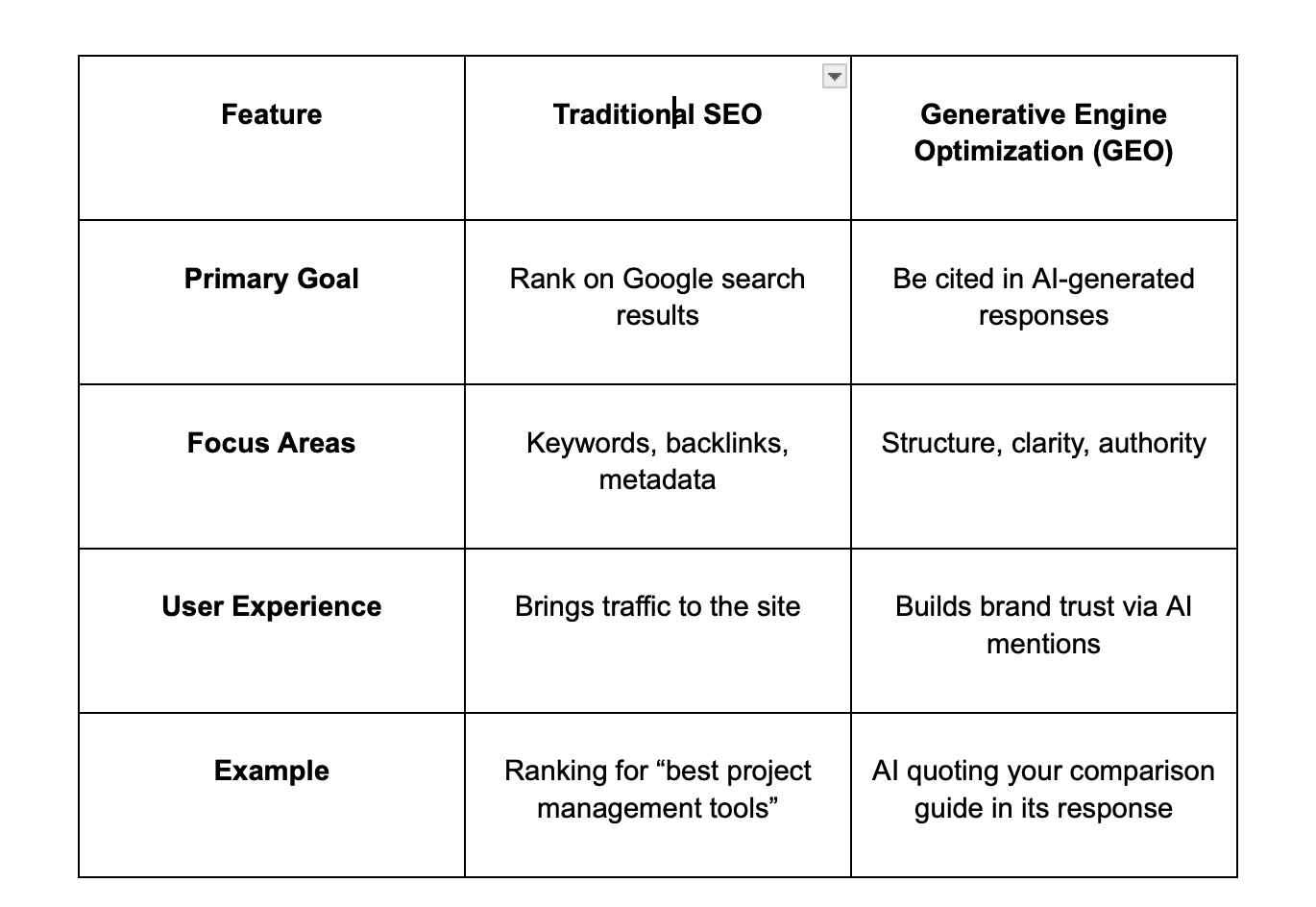What Is Generative Engine Optimization (GEO)? A Complete Guide
Photo credit: Pexels: Tara Winstead
Seen the new AI search results at the top of Google or Bing? Want your website mentioned in those top paragraphs? That, in a nutshell, is GEO. Creating content that makes it easy for AI to mention you. This guide explains what Generative Engine Optimization is and its importance in digital marketing. Discover how to develop a successful GEO strategy for better rankings in an AI-driven digital landscape.
Online search is changing rapidly. Not too long ago, digital marketing focused around SEO, using keyword strategies to match with terms users frequently search for. Striving for high rankings on Google and Bing is a core piece of marketing strategy. But now, AI tools like ChatGPT, Google Gemini, and Perplexity are creating more complex results in search engines.
No longer just providing a set of links to choose from, search engines now offer more comprehensive information and conversational answers with AI directly in the search result. For businesses looking to stay at the top of search results, maximizing Generative Engine Optimization (GEO) becomes relevant.
What Is Generative Engine Optimization (GEO)?
Traditional SEO strategy focuses on creating keyword rich website copy and ultra valuable content to maximize a website’s position in the search results. GEO, on the other hand, makes it easy for AI engines to comprehend, summarize, and make recommendations from content directly to users. This is the new frontier in online visibility.
For marketers and business owners, GEO is now an essential part of a digital marketing plan. A well-crafted GEO-strategy ensures your content not only appears in search results, but becomes the source AI engines rely on to formulate responses.
For effective generative engine optimization (GEO), brands must organize and draft content in a way that makes it easy for AI to read, comprehend, and recommend it.
Search engine optimization focuses on keywords, backlinks, and metadata. And these are still essential for ranking. But GEO puts focus on the following:
Clarity: Clear, direct responses that are easy to understand.
Structure: Incorporating headings, lists, and FAQs to help AI to scan easily.
Credibility: Well-researched, extensive, and authoritative data.
Readability: Straightforward, conversational, and human-friendly prose.
An effective GEO strategy involves all of these components and helps your content and web copy to align with generative engines to analyze and relay information
Why GEO Matters for Digital Marketing
The foundation of digital marketing is always visibility, but the way people access online information has shifted. We are now in the era of GEO digital marketing and more people are turning to AI tools for instant, conversational answers, and shifting attention away from traditional search engines
Here's why GEO ranking is essential for digital marketing today:
Higher AI Visibility
With strong GEO practices, your website and content are more likely to be shown in AI search responses. An improved GEO ranking means your brand is mentioned more frequently.
Trust and Credibility
When AI tools reference your content, it positions you as an authority in your field. Think of this as a digital recommendation, establishing trust and credibility with readers and potential clients.
Competitive Advantage
Paying attention to GEO offers a competitive advantage, as most businesses are still relying on traditional search strategies for content. Early adopters of GEO can gain a significant advantage by securing a good head start.
GEO vs Traditional SEO: Key Differences
A good GEO strategy does not abandon SEO principles. It uses both to create maximum visibility and results. SEO components are necessary to attract organic traffic, and infusing GEO into your content ensures it remains visible when AI engines generate responses.
There is a lot of crossover between Generative Engine Optimization and SEO principles, but they serve different purposes. Here's how:
Best Practices for GEO in Content Marketing
So, what are the best practices for GEO in content marketing? Writing in a conversational tone, answering questions directly–without fluff, and utilizing organizational tools such as lists and FAQs.
Writing this way is helpful for your readers, as most people skim content quickly, but it’s also very beneficial for AI engines.
Here are some practical measures for GEO for content marketing that every brand should adopt.
1. Answer questions directly.
If someone asks, "What is Generative Engine Optimization?" don't let them scroll. Provide it upfront, within the first sentence. AI tools prefer clear, fast answers.
2. Structure articles for scanning.
No matter how much effort you pour into your content, people are going to scan it. We only have so much attention to spend in a day. Readers want to find what they need quickly, and will move on if they don’t find it.
Here are some key tips to help you structure articles for better geo rankings:
Use H2 and H3 headings that reflect common search queries
Keep paragraphs short (2-3 sentences)
Use numbered and bulleted lists
Provide a summary to reinforce your message in the conclusion
3. Add FAQs.
The FAQs in your content are a powerful way to reflect the way users ask questions. AI tools often pull answers directly from them.
4. Prioritize clarity over jargon.
Simple, clear writing wins. If AI has difficulty understanding your writing, it is likely to ignore it. So are humans. Always keep content easy to read for people, and robots.
5. Build credibility.
Content referencing trusted authors, case studies, or statistics is more likely to gain the trust of the readers and the AI engines.
GEO Optimization Strategies for AI Search Results
Like SEO, some precise tinkering can make huge changes to your brand’s visibility. Let's examine some GEO optimization strategies for AI search results.
Focus on semantic relevance.
Don't just stuff exact keywords into content. For the reader’s sake as much as AI. You can use different phrases to describe the search intent. Using the example of “GEO strategies”, you can also use “improving GEO,” or GEO digital marketing to create well rounded search results.
Write in-depth content.
Surface content won't cut it anymore. Dig deeper to adequately cover a topic so AI engines can see that you have something to share worth reading.
Use Q&A formats.
Most AI engines prefer structured content in a Q&A format. This increases the likelihood that your answers will be selected for AI results.
Stay updated.
AI is evolving quickly. Regularly audit and refresh your material to ensure your content remains relevant and accurate.
How to Improve Your GEO Strategy
Wondering how you can better incorporate GEO into your content strategy? Consider these steps to fine-tune your digital marketing:
Audit your current content: Review the content you already have. Ask yourself, are your articles truly helpful? Are they easy to scan?
Enhance readability: Break text into shorter sentences. Use plain language and incorporate visual aids wherever possible.
Write for conversation: Imagine your target audience is asking you questions directly. Then, provide clear and direct answers as you would to a real human.
Evaluate AI visibility: See whether your pages receive citations by AI generative engines. Continually revise your strategy based on the findings.
Adapt quickly: You must respond to shifts rapidly. Build time into your marketing to consistently make sure you know where you stand.
Shape the Future of Search with GEO at Trabin Communications
The way people search has evolved, and there’s no fighting it. GEO is no longer optional and brands must adapt their strategies accordingly to keep up.
The upside? Integrating GEO digital marketing into your traditional strategy means your brand isn't just visible; it earns real trust and can be continually referenced in AI-generated responses.
If you don’t have time for all of that, let us take care of it for you. Rich, value-packed content has always been our thing. And GEO infused strategies are just another way we can take the pressure off busy clients.
Are you ready to move into the future with Trabin Communications by your side? Book a call today.
Frequently Asked Questions
1. What is Generative Engine Optimization (GEO)?
GEO involves creating content in a way that is easy for AI-enabled search engines to read, comprehend, and recommend your website.
2. How is GEO different from SEO?
Search Engine Optimization aims for a specific ranking on Google search results. In contrast, GEO improves the chances your content is consistently recommended by AI-generated results, by making it easier for engines to understand and cite.
3. What are the best practices for GEO in content marketing?
GEO best practices include writing clearly, using strategic headings, including FAQ sections, and referencing authoritative materials.
4. How to structure articles for better GEO rankings?
An article aiming for better Google rankings should answer a question immediately. nclude a clear introduction, use H2 and H3 headings, keep paragraphs concise, and conclude with a strong summary. An FAQ section also helps improve GEO performance.
5. How can GEO improve digital marketing results?
GEO enhances trust, increases a brand's authority, and drives greater brand engagement online by increasing visibility in AI-generated content outputs.


